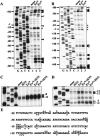DNA looping-mediated repression by histone-like protein H-NS: specific requirement of Esigma70 as a cofactor for looping
- PMID: 16204188
- PMCID: PMC1240047
- DOI: 10.1101/gad.1316305
DNA looping-mediated repression by histone-like protein H-NS: specific requirement of Esigma70 as a cofactor for looping
Abstract
Transcription initiation by RNA polymerase (RNP) carrying the house-keeping sigma subunit, sigma70 (Esigma70), is repressed by H-NS at a number of promoters including hdeABp in Escherichia coli, while initiation with RNP carrying the stationary phase sigma, sigma38 (Esigma38), is not. We investigated the molecular mechanism of selective repression by H-NS to identify the differences in transcription initiation by the two forms of RNPs, which show indistinguishable promoter selectivities in vitro. Using hdeABp as a model promoter, we observed with purified components that H-NS, acting at a sequence centered at -118, selectively repressed transcription by Esigma70. This selective repression is attributed to the differences in the interactions between hdeABp and the two forms of RNPs, since no other factor is required for the repression. We observed that the two forms of RNPs could form an open initiation complex (RP(O)) at hdeABp, but that Esigma70 failed to initiate transcription in the presence of H-NS. Interestingly, KMnO4 assays and high-resolution atomic force microscopy (AFM) revealed that hdeABp DNA wrapped around Esigma70 more tightly than around Esigma38, resulting in the potential crossing over of the DNA arms that project out of Esigma70 . RP(O) but not out of Esigma38 . RP(O). Based on these observations, we postulated that H-NS bound at -118 laterally extends by the cooperative recruitment of H-NS molecules to the promoter-downstream sequence joined by wrapping of the DNA around Esigma70 . RP(O), resulting in effective sealing of the DNA loop and trapping of Esigma70. Such a ternary complex of H-NS . Esigma70 hdeABp was demonstrated by AFM. In this case, therefore, Esigma70 acts as a cofactor for DNA looping. Expression of this class of genes by Esigma38 in the stationary phase is not due to its promoter specificity but to the architecture of the promoter . Esigma38 complex.
Figures






Similar articles
-
Factors influencing preferential utilization of RNA polymerase containing sigma-38 in stationary-phase gene expression in Escherichia coli.J Microbiol. 2004 Jun;42(2):103-10. J Microbiol. 2004. PMID: 15357303
-
The bacterial DNA-binding protein H-NS represses ribosomal RNA transcription by trapping RNA polymerase in the initiation complex.J Mol Biol. 2000 May 19;298(5):737-48. doi: 10.1006/jmbi.2000.3708. J Mol Biol. 2000. PMID: 10801345
-
Molecular analysis of the regulation of csiD, a carbon starvation-inducible gene in Escherichia coli that is exclusively dependent on sigma s and requires activation by cAMP-CRP.J Mol Biol. 1998 Feb 20;276(2):339-53. doi: 10.1006/jmbi.1997.1533. J Mol Biol. 1998. PMID: 9512707
-
ppGpp: a global regulator in Escherichia coli.Trends Microbiol. 2005 May;13(5):236-42. doi: 10.1016/j.tim.2005.03.008. Trends Microbiol. 2005. PMID: 15866041 Review.
-
Interplay of global regulators and cell physiology in the general stress response of Escherichia coli.Curr Opin Microbiol. 1999 Apr;2(2):148-52. doi: 10.1016/S1369-5274(99)80026-5. Curr Opin Microbiol. 1999. PMID: 10322169 Review.
Cited by
-
Comparative analysis of the regulation of rovA from the pathogenic yersiniae.J Bacteriol. 2007 Aug;189(16):5963-75. doi: 10.1128/JB.00528-07. Epub 2007 Jun 15. J Bacteriol. 2007. PMID: 17573476 Free PMC article.
-
Role of nucleoid-associated proteins Hha and H-NS in expression of Salmonella enterica activators HilD, HilC, and RtsA required for cell invasion.J Bacteriol. 2007 Oct;189(19):6882-90. doi: 10.1128/JB.00905-07. Epub 2007 Aug 3. J Bacteriol. 2007. PMID: 17675384 Free PMC article.
-
Decrypting the H-NS-dependent regulatory cascade of acid stress resistance in Escherichia coli.BMC Microbiol. 2010 Oct 29;10:273. doi: 10.1186/1471-2180-10-273. BMC Microbiol. 2010. PMID: 21034467 Free PMC article.
-
A novel balanced-lethal host-vector system based on glmS.PLoS One. 2013;8(3):e60511. doi: 10.1371/journal.pone.0060511. Epub 2013 Mar 28. PLoS One. 2013. PMID: 23555984 Free PMC article.
-
Gene order and chromosome dynamics coordinate spatiotemporal gene expression during the bacterial growth cycle.Proc Natl Acad Sci U S A. 2012 Jan 10;109(2):E42-50. doi: 10.1073/pnas.1108229109. Epub 2011 Dec 19. Proc Natl Acad Sci U S A. 2012. PMID: 22184251 Free PMC article.
References
-
- Aki T., Choy, H.E., and Adhya, S. 1996. Histone-like protein HU as a specific transcriptional regulator: Co-factor role in repression of gal transcription by GAL repressor. Genes Cells 1: 179-188. - PubMed
-
- Arnqvist A., Olsen, A., and Normark, S. 1994. σ S-dependent growth-phase induction of the csgBA promoter in Escherichia coli can be achieved in vivo by σ 70 in the absence of the nucleoid-associated protein H-NS. Mol. Microbiol. 13: 1021-1032. - PubMed
-
- Atlung T. and Ingmer, H. 1997. H-NS: A modulator of environmentally regulated gene expression. Mol. Microbiol. 24: 7-17. - PubMed
-
- Badaut C., Williams, R., Arluison, V., Bouffartigues, E., Robert, B., Buc, H., and Rimsky, S. 2002. The degree of oligomerization of the H-NS nucleoid structuring protein is related to specific binding to DNA. J. Biol. Chem. 277: 41657-41666. - PubMed
-
- Bordes P., Repoila, F., Kolb, A., and Gutierrez, C. 2000. Involvement of differential efficiency of transcription by eσs and eσ70 RNA polymerase holoenzymes in growth phase regulation of the Escherichia coli osmE promoter. Mol. Microbiol. 35: 845-853. - PubMed
Publication types
MeSH terms
Substances
LinkOut - more resources
Full Text Sources
Molecular Biology Databases
Miscellaneous
